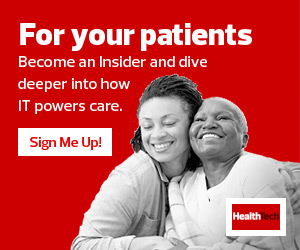The Technology Provides Instant Results
When the pandemic first surged, Tampa General Hospital quickly learned that taking people’s temperatures manually used excessive resources — up to 30 employees at one entrance at any one time.
“It wasn’t the most efficient process,” says Scott Arnold, CIO for the organization.
Tampa General soon after installed two thermal scanners that require just two people to manage each unit: an attendant and a security guard.
Facial recognition software can identify and scan up to 14 faces simultaneously. If anyone has a body temperature of more than 99 degrees, the scanner emits audible and visual alarms. The person then gets scanned again, and if the reading is still too high, that individual gets sent to a health station for additional screening.
“We transformed our screening process so that it’s noninvasive,” Arnold says. “In fact, we have people asking us why we’re not screening anymore. It’s like with security cameras in malls: You don’t realize the camera is there, but it’s there performing the screening.”
In March, Memorial Hermann-Texas Medical Center set up manual temperature screening stations at the Houston hospital’s five entrances, where a collective 6,000 people pass through each day. That effort generally required four to 12 temperature-taking staffers at each entrance and it led to long lines of people grouping together.
The hospital then opted to place a thermal camera, each costing about $10,000, at each of its two highest-traffic entrances. The cameras capture both the black body and the individual in the same frame. The device reads the skin temperature in the corner of an individual’s eye, which research suggests is the facial area that best reflects core temperature.
If a person has a reading of 99.3 degrees Fahrenheit or higher, Memorial Hermann-TMC teams use a second device, such as a handheld infrared camera or a temporal thermometer. If the temperature is still too high, that individual cannot enter the facility.
Still, thermal scanners are not foolproof. And it can take 14 days to show symptoms after contracting COVID-19.
“It’s clear that elevated body temperature is only one symptom of COVID-19, and not everyone who has it gets a temperature,” says John Calhoun, director of hospital operations at Memorial Hermann-TMC, which plans to acquire two more cameras for expanded screenings.
Shifts in Screening Lead to Success
Certain environmental factors also can affect thermal cameras. As noted in guidelines released by the Food and Drug Administration, these include air flow, strong lighting, direct sunlight, radiant heat and reflective backgrounds, and hospitals must plan accordingly.
A pilot run compelled Memorial Hermann-TMC leaders to place scanners higher to point downward, avoiding direct light from adjacent windows. Tampa General also has plenty of windows at its entrances; shades were installed to help.
Clothing such as hats, headscarves and sunglasses can impede the scanners’ ability to get a correct read. Tampa General installed digital signage outside its entrance instructing people to remove their hats and sunglasses.
Exercise can raise body temperature too, so Tampa General staffers ask people with high temperature readings if they have just exercised; those who say yes are given a few minutes to rest before trying again.
The biggest benefit for Tampa General: No cases of COVID-19 have been acquired within the hospital since thermal screening began.
“Our team members are very happy we’re doing this — and in a noninvasive way, so they can just walk in to work like they did before coronavirus, without waiting in line for 10 to 15 minutes to get screened manually,” Arnold says.
The technology, adds Calhoun of Memorial Hermann, delivers a clear business value to hospitals that need to revive services and convince reluctant patients to seek care: “Thermal scanning will be required because customers will expect it.”











